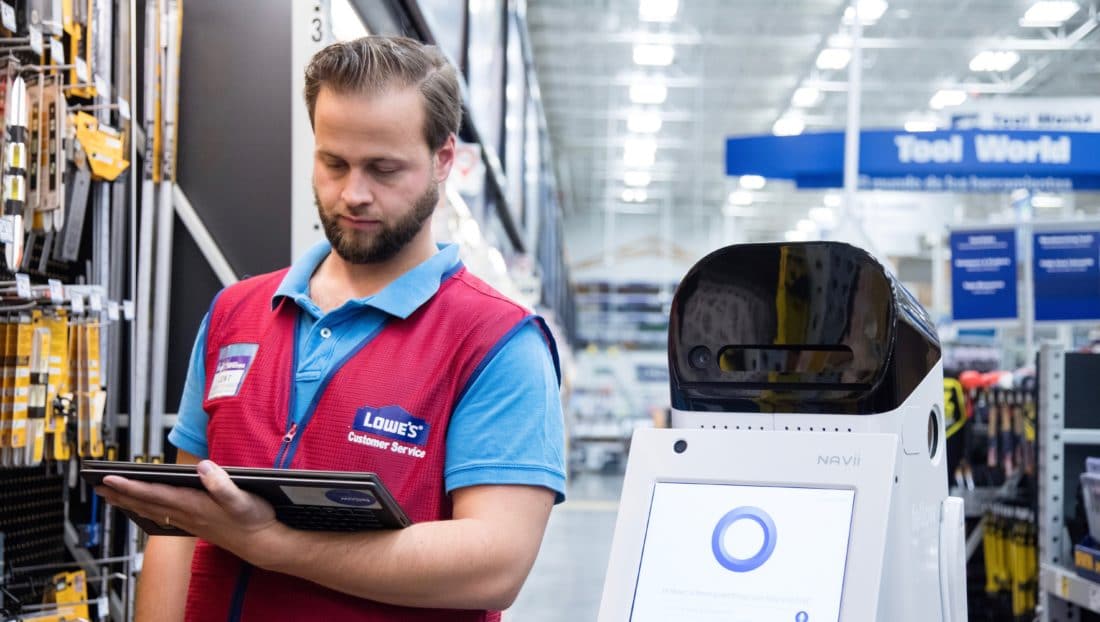Strolling the floor of the National Retail Federation’s Big Show last week, it was hard to tell if the convention was a meeting of retailers or an offshoot of the Consumer Electronics Show that had ended days earlier in Las Vegas. A cheery humanoid robot named Pepper served as door host at the SAP booth. In other booths, less shapely automatons demonstrated how they stocked shelves and scanned for inventory.
Beyond robotics—a highlight of the show—there were countless examples of artificial intelligence, facial recognition, geolocation, and virtual and augmented reality on display. Retailers studied specifications on “magic mirrors” that let shoppers try on makeup without applying it, store displays that can change based on the demographics of the person passing by or systems that analyze which items shoppers look at and try and suggest merchandise changes.
“We believe there is a lot of disruption, and that technology is playing a big role in it,” said Stephen Laughlin, VP and general manager, Global Consumer Industry at IBM. “Yesterday’s harebrained idea is tomorrow’s game-changing play.”
A study released by SAP at the NRF show found that 44% of large retailers and 50% of midsized ones expect revenue to be 5% to 10% higher next year due to digital transformation. But true game-changing plays will require collaboration, said many of the exhibitors. Many companies are partnering to provide shopper experience platforms to meet the challenge.
“Knitting together the right tapestry of alliances is how you’re going to win in these next 10 or 15 years,” said Steve Case, CEO of VC firm Revolution. “You have to figure out … how to be more partner friendly. Most organizations are not.”
The future shopper experience will resemble e-commerce more than a brick-and-mortar shop. The consensus at NRF is that the digital experience is driving customers’ expectations and retailers will have to match them.
“This is going to be an interesting year for retailers to think: ‘How am I going to transform my store to make it a destination?’” said Keith Sherry, COO of SATO Global Solutions. The company is working with Untuckit, an apparel line that started online and is now venturing into bricks and mortar.
“Bringing that online experience into the store requires a lot more technology,” said Sherry. SATO has partnered with Intel Corp. to combine its data analytics with Intel’s Internet of Things platform to build store experience solutions.
“Now we’re at that beautiful point of transformation in the industry,” said Sherry. “The right organizations are coming together.”
RIoT Insight, another Intel partner, has a deployment with sportswear company G-Star that uses radio frequency identification (RFID) and overhead sensors to keep track of inventory on the sales floor. The solution generates real-time data to flag when stock is needed on the floor and it also alerts the online sales unit to fine-tune its assortment based on store sales.
“This is really about intelligent shopping,” said Ryan Parker, Intel general manager, Responsive Retail. “We’re trying to find all the best-in-breed people.”
Across the show floor, Cisco had a dozen partners working behind the scenes to build its model store on the trade show floor, noted Jeremy Witikko, Global Consumer Industries Advisor. The systems it displayed included applications to assist store associates to recognize repeat customers and in-store cameras that can track and segment using facial recognition.
Artificial intelligence combined with facial recognition is improving on the old traffic statistics by segmenting the store foot traffic by age, gender and ethnicity. Combining those tools with RFID and tracking software, merchants can further understand what shoppers look at, and which items they buy or not.
Shiny objects
The data will be useful as retail changes its business strategy to focus on new strategies for growth, said industry insiders. They noted that merchants are turning from seeking growth by opening more stores to increasing sales at existing stores as a path to profits.
In the past, a successful apparel retailer would be overstocked and over-assorted, said Matt Laukaitis senior VP and general manager of SAP Retail. With the new systems, they can make more targeted selections of what they will need to have on hand and keep a smaller inventory, thanks to fast fashion and just-in-time production.
“Shiny objects… are not so shiny anymore,” said Laughlin. Technologies such as AR and VR used to be the domain of 12-year-old gamers, but not anymore, he said. With the Apple ARKit toolset that was released last year, retailers can build AR tools that can show shoppers how different apparel pieces would look together, or the nutritional information of a food item on a store shelf, said Laughlin.
“It starts with customer-designed thinking,” said Laughlin. “You have to think through the process with the customer.”
That will be a challenge of its own. For retailers, starting down the digital path was often internally-driven; management decided it needed a website or mobile app and one was built, said Matthew Leach, VP business analysis & project management at NTT Data services. This was an “inside-out approach to innovation,” he said. Now, the innovation is driven by insights and an understanding of the customer journey, he said. But NTT released a study at the NRF show that showed that traditional retailers are trailing in improving customer experience.
“We’re trying to shift the conversation to the customer experience,” said Leach. “That’s how you build global brands.”
